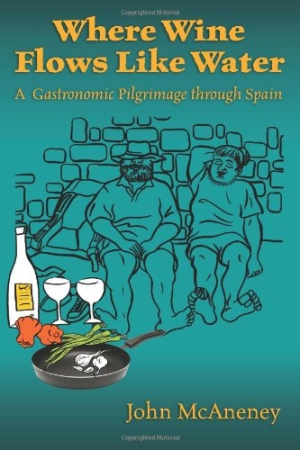Where Wine Flows like Water
A Gastronomic Pilgrimage across Spain
This is the second edition of New Zealander John McAneney’s amusing account of his trip, undertaken largely on a whim, following an ancient Spanish pilgrimage trail. McAneney retains most of the original text of the book published in 1997, but updates it with some new recipes.
McAneney and his friend Pete start their journey in Bordeaux, France, and then make their way to the base of the French Pyrenees to begin their trek to Santiago de Compostela in northwestern Spain, a journey of between nine hundred and one thousand kilometers (620 miles or so). Along the way, the two travelers eat heartily, meet a wide variety of colorful characters, and, of course, imbibe a great deal of wine.
As a travel memoir, the book is nothing if not amusing. The reader cannot help but smile, and at times laugh out loud, at McAneney’s and Pete’s various escapades, which range from blisters on their feet to bouts of illness to drunken meanderings. Equally amusing is McAneney’s writing style. For example, “The guidebook waxed lyrical about the beauties of Navarette, but today it seemed just a collection of mud-colored houses on the side of a hill. A town without charm inhabited by surly people. Perhaps I missed something.” Yet McAneney is equally capable of painting evocative scenes: “snow-capped mountains, forest-covered lower slopes, and the sound of surging water in the river below.”
Through McAneney’s eyes, the reader will enjoy an intimate portrait of the people, small towns, and cuisine of an area of Spain that most people will likely never visit. The author shares numerous vignettes but keeps the story moving through breezy writing and short chapters. Of special interest are the recipes of authentic dishes that populate the book which, McAneney advises the reader, are “the plates of everyday life” rather than “the fare of celebrity chefs.” In addition to including the ingredients and instructions for preparation, McAneney often adds an amusing comment or two that sets each recipe apart. For instance, “Picasso had his blue period and I’m currently going through a caramel one. Just throw the following ingredients together and relax over what remains of the cooking wine.” The recipes serve to both complement the diary-like narrative and literally add local flavor to the book.
In the last chapter, McAneney reflects on his journey: “Adventure, curiosity, spirituality, mid-life crises? Or just plain fun? All these had been touted at home to explain our self-indulgence. The result had been much more, with the spiritual, historic, artistic, sociological and gastronomic dimensions of the pilgrim route each contributing towards a smorgasbord of experience.” While the reader may have viewed the author’s romp as simply an amusing tale, the impact of the pilgrimage on McAneney becomes clear at the end. That makes reading Where Wine Flows Like Water all the more meaningful.
Reviewed by
Barry Silverstein
Disclosure: This article is not an endorsement, but a review. The publisher of this book provided free copies of the book and paid a small fee to have their book reviewed by a professional reviewer. Foreword Reviews and Clarion Reviews make no guarantee that the publisher will receive a positive review. Foreword Magazine, Inc. is disclosing this in accordance with the Federal Trade Commission’s 16 CFR, Part 255.

